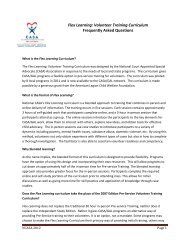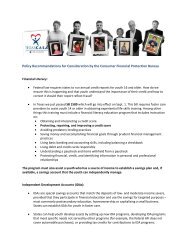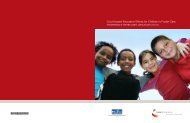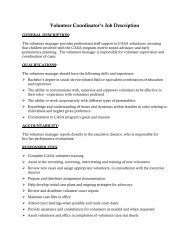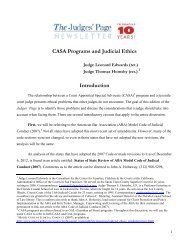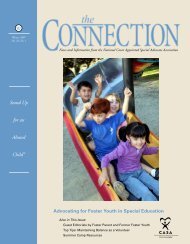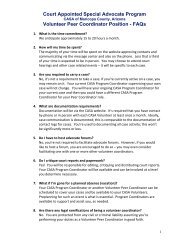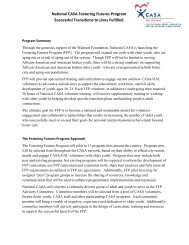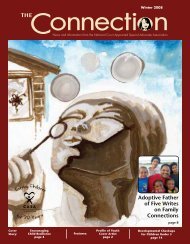(CASA) Association 2012 National Statistics - National CASA
(CASA) Association 2012 National Statistics - National CASA
(CASA) Association 2012 National Statistics - National CASA
Create successful ePaper yourself
Turn your PDF publications into a flip-book with our unique Google optimized e-Paper software.
<strong>National</strong> Court Appointed Special Advocate (<strong>CASA</strong>) <strong>Association</strong>2014 <strong>National</strong> <strong>Statistics</strong>Following are the latest statistics available at the time of publication. Visit the Child Welfare Information Gateway atchildwelfare.gov for updates and other powerful figures on the needs of abused and neglected children.A Nationwide Program of Advocacy for Abused and Neglected Children• In 2013, the <strong>CASA</strong>/GAL network consisted of 951 local and state programs. All programs are united in theirmission to provide quality advocacy for abused and neglected children in the court system and adhere tocomprehensive program standards. i• In 2013, <strong>CASA</strong>/GAL programs had 74,918 volunteers donate over 5.75 million hours to making a lifelongdifference in the lives of abused and neglected children. In that year, approximately 21,966 new volunteers weretrained to help meet the need. ii• An estimated 238,527 children were served by <strong>CASA</strong>/GAL volunteers in 2013. iiiChanges over the past five years in the number of <strong>CASA</strong>/GAL volunteers and children served. ivYear <strong>CASA</strong>/GAL Volunteers Children Served2009 70,919 237,0952010 75,087 240,1642011 77,021 234,238<strong>2012</strong> 77,355 234,0982013 74,918 238,527A SOLUTION THAT WORKS—THE COURT APPOINTED SPECIAL ADVOCATEPROGRAM (<strong>CASA</strong>/GAL)Better Outcomes Proven for Children<strong>CASA</strong>/GAL volunteers make sure that the abuse and neglect that the children originally suffered at home does notcontinue as abuse and neglect at the hands of the system.• Low <strong>CASA</strong> caseloads mean the courts can make better decisions for children. <strong>CASA</strong> volunteers handle just 1 or2 cases at a time, so that they can give each child’s case the sustained, personal attention he or she deserves. v1 | P a g e
• Children with <strong>CASA</strong> volunteers spend 7.5 months less in foster care, experience fewer out of home placementsand have significantly improved educational performance. vi• More than 90% of children with <strong>CASA</strong> volunteers never reenter the child welfare system, a significant differencecompared to the general foster care population. This outcome also results in significant savings in child welfareexpenses. vii• Complex cases receive more attention so they can move forward in a timely way. <strong>CASA</strong> volunteers are typicallyappointed to the more complex children’s cases – those where there are multiple risk factors which must be fullyunderstood in order to make a placement decision that will be in the child’s best interests. viii• More effective use of service dollars. Children with <strong>CASA</strong> volunteers, and their families, receive more courtorderedservices and because of the volunteer’s detailed knowledge of the child’s circumstances, those servicesare more carefully targeted and monitored. ixCost Effectiveness• <strong>CASA</strong> volunteers save hundreds of millions of dollars in child welfare costs alone. Federal law requires thatjuvenile and family courts appoint a guardian ad litem, who may be an attorney or <strong>CASA</strong>/GAL volunteer, in allcases of child abuse and neglect. x• The child welfare system could not afford to provide a comparable level of advocacy through non-volunteerapproaches. In 2013, <strong>CASA</strong> volunteers contributed 5.75 million advocacy hours, equivalent to $290 million intaxpayer dollars if compensated for their service. xi• By reducing long-term placements, subsequent victimization, and reentry into the foster care system, <strong>CASA</strong>substantially reduces child welfare costs. xii• 75 to 1 return on investment. Federal funding for one staff supervisory position within a local <strong>CASA</strong> programsupports 30 trained volunteer workers, assigned to 75+ children’s cases within a year. xiiiHigh Quality Advocacy• Judges assign <strong>CASA</strong>/GAL volunteers to 37% of abuse and neglect cases before them. They express a great needfor more volunteers for their cases. xiv• <strong>CASA</strong> volunteers assure that the court and child welfare systems remain focused on children’s well-being,assuring that the specific needs of individual children, including their needs for safety and permanency, areaddressed expeditiously. xv• Judges, attorneys, child welfare workers, and parents overwhelmingly report that <strong>CASA</strong> volunteers make adifference with the children they serve. xvi• With a limited number of available volunteers, judges assign <strong>CASA</strong>/GAL volunteers to their most difficult andcomplex cases: those with prior maltreatment or contact with child welfare, cases of extreme neglect, physical orsexual abuse, and those where children have a great level of risk. xvii2 | P a g e
• <strong>CASA</strong> volunteers are far more likely than paid attorneys to visit children in their homes, more likely to investigatewhether there are appropriate services for the child or family, and to monitor delivery of services. xviiiEfficiency• Since <strong>CASA</strong> is a program of citizen volunteers, funds invested deliver a quick and impressive return in terms ofchildren served within communities. Federal funding is turned around by <strong>National</strong> <strong>CASA</strong> within months ascompetitive, peer-reviewed grants to <strong>CASA</strong> programs.• Funding from the Justice Department is awarded through a competitive, external review process. By contractingwith the <strong>National</strong> <strong>CASA</strong> <strong>Association</strong> to administer the <strong>CASA</strong> grants program, the Department of Justice is ableto assure effective utilization of funds, in compliance with federal regulations and <strong>National</strong> <strong>CASA</strong> standards.• Grants awarded by <strong>National</strong> <strong>CASA</strong> allow a large number of communities (140 grants in 2013) to expandvolunteer advocacy without becoming dependent upon a single source of revenue. <strong>CASA</strong> programs leverage thefederal investment to attract a greater percentage of state, private and court funding to support advocacy withintheir communities. xixChildren Continue to Need Protection and Care• Approximately 3.5 million allegations of child abuse and neglect involving 6.4 million children were made toCPS agencies in Federal Fiscal Year 2013. xx• In 2013, an estimated 678,932 children were substantiated as victims of child maltreatment, a rate of 9.1 per1,000 children in the US and Puerto Rico. xxi• African American children, American Indian or Alaska Native children and children of multiple races had thehighest rates of victimization at 14.6, 12.5, and 10.6 victims per 1,000 children, respectively. Hispanic childrenand White children had rates of 8.5 and 8.1 per 1,000 children, respectively. Asian children had the lowest rateof 1.7 per 1,000 children. Nearly one-half of all victims were White (44%), one-fifth (21.2%) were AfricanAmerican, and one-fifth (22.4%) were Hispanic. xxii• The youngest children (from birth through age 3) were most likely to be determined to be maltreated comparedto all other age groups and the victimization rate was highest for children younger than 1 year (23.1 per 1,000children in the population of the same age).. xxiii• An estimated 1,520 children nationally (compared to 1,630 children for FFY <strong>2012</strong>) died from abuse or neglect.The rate per 100,000 children was 2.04 deaths for FFY 2013 compared to a rate of 2.19 for FFY <strong>2012</strong>.Children 0–3 years old accounted for 73.9% of child fatalities. Children younger than 1 year old accounted for46.5% of all child fatalities. xxiv• Violence often occurs against women and children in the same family. Research indicates that 50–70% of menwho assault their female partners also abuse their children. xxv• 641,000 children were in foster care in FY 2013. They spent a mean of 21.8 months in foster care. xxvi3 | P a g e
The race/ethnicity breakdown of the children in foster care as of September 30, 2013, is as follows: xxviiEthnicity Percentage Total ChildrenCaucasian 42% 168,302African American 24% 98,201Hispanic (of any race) 22% 86,993American Indian/Alaskan Native 2% 8,652Asian American 1% 2,114Hawaiian/Pacific Islander 0% 686Unknown 3% 11,734Two or more races 6% 24,935• Of the children in foster care on September 30, 2013, 101,840 were waiting to be adopted. Only 50,608children were adopted from the public foster care system in FY 2013. xxviii• States spent $29.4 billion in federal, state and local funds on child welfare programs in SFY 2010. This is a 2%increase between SFY 2008-2010 after adjusting for inflation. xxix• In SFY 2010, states spent $13.6 billion in federal dollars, $12.5 billion in state dollars and $3.3 billion in localdollars. Between SFY 2006 and SFY 2010, federal spending increased by 5%, state spending increased by 5%,and local spending declined by 23%. xxxTotal Annual Cost of Child Abuse and Neglect in the United States—Direct Costs (costs associated with the immediateneeds of abused or neglected children): xxxiServicesAnnual Estimated Direct CostAcute Medical Treatment $2,907,592,094Mental Health Care System $1,153,978,175Child Welfare Services System $29,237,770,193Law Enforcement $34,279,048Total Direct Cost $33,333,619,5104 | P a g e
Total Annual Cost of Child Abuse and Neglect in the United States—Indirect Costs (costs associated with long-term andsecondary effects of child abuse and neglect): xxxiiServicesAnnual Estimated Indirect CostSpecial Education $826,174,734Early Intervention $247,804,537Emergency/Transitional Housing $1,606,866,538Juvenile Delinquency $3,416,149,283Mental Health and Health Care $270,864,199Adult Criminal Justice System $32,724,767,699Lost Productivity to Society $7,834,164,589Total Indirect Cost $46,926,791,578TOTAL ANNUAL DIRECT AND INDIRECT COST OFCHILD ABUSE AND NEGLECT:$80,260,411,087• The Centers for Disease Control (CDC) projects the annual cost is even higher – at $124 billion. According tothe CDC, the average cost for each child victim is $210,012 over that victim’s lifetime. xxxiii• Abuse is associated with a range of other risks—juvenile delinquency, suicide, unemployment and poor schoolperformance. xxxivEndnotesi <strong>National</strong> <strong>CASA</strong> <strong>Association</strong>, 2013 <strong>National</strong> <strong>CASA</strong> <strong>Association</strong> Annual Local Program Survey, Seattle, WA, (2014).<strong>CASA</strong>forChildren.orgii Ibidiii Ibidiv Ibidv Caliber Associates, <strong>National</strong> <strong>CASA</strong> <strong>Association</strong> Evaluation Project, Fairfax, Virginia, 2004.5 | P a g e
vi Calkins and Miller, The Effectiveness of Court Appointed Special Advocates to Assist in Permanency Planning, 1999and Waxman, Houston, Profilet & Sanches, The Long-Term Effects of the Houston Child Advocates Inc. Program onChildren and Family Outcomes, Child Welfare, vol. 88 #6, pp. 25 – 48, Child Welfare League of America, Nov/Dec2009.vii Office of the Inspector General, Audit Report 07-04, <strong>National</strong> Court Appointed Special Advocate Program,December 2006.viii Evaluation of Court Appointed Special Advocate/Guardian ad Litem Volunteer Impact, Organizational ResearchServices, September, 2005.ix Office of the Inspector General, op. cit.x Child Abuse Prevention and Treatment Act, Sect. 106, w.B.xiii, P.L. 111-320, as amended 2010.xi <strong>National</strong> <strong>CASA</strong> <strong>Association</strong>, 2013 <strong>National</strong> <strong>CASA</strong> <strong>Association</strong> Annual Local Program Survey, Seattle, WA, (2014).<strong>CASA</strong>forChildren.orgxii Office of the Inspector General, op. cit.xiii <strong>National</strong> <strong>CASA</strong> <strong>Association</strong> Standards for Local <strong>CASA</strong>/GAL Programs, <strong>2012</strong> edition, p. 30 and <strong>National</strong> <strong>CASA</strong><strong>Association</strong>, 2013 <strong>National</strong> <strong>CASA</strong> <strong>Association</strong> Annual Local Program Survey, Seattle, WA, (2014). <strong>CASA</strong>forChildren.orgxiv Evaluation of Court Appointed Special Advocate/Guardian ad Litem Volunteer Impact, Judicial Survey,Organizational Research Services, September 2005.xv Ibid.xvi Ibid.xvii Ibid.xviii Ibid.xix <strong>National</strong> <strong>CASA</strong> <strong>Association</strong>, 2013 <strong>National</strong> <strong>CASA</strong> <strong>Association</strong> Annual Local Program Survey, Seattle, WA, (2014).<strong>CASA</strong>forChildren.orgxx U.S. Department of Health and Human Services, Administration for Children and Families, Administration onChildren, Youth and Families, Children’s Bureau. (2014). Child maltreatment 2013. Available fromhttp://www.acf.hhs.gov/programs/cb/research-data-technology/statistics-research/child-maltreatment.xxi Ibid.xxii Ibid.xxiii Ibid.xxiv Ibid.xxv McKibben, L., DeVos, E. & Newberger, E., “Victimization of mothers of abused children: A controlled study.”Pediatrics, 84:531 (1989); Start, E. & Flitcraft, A., “Women and children at risk: A feminist perspective on child abuse.”International Journal of Health Services, 18:97 (1988).6 | P a g e
xxvi US Department of Health and Human Services (DHHS), Administration on Children, Youth, and Families,Children’s Bureau, The Adoption and Foster Care Analysis and Reporting System Report (AFCARS), Washington, DC(2014). http://www.acf.hhs.gov/programs/cb/resource/trends-in-foster-care-and-adoptionhttp://www.acf.hhs.gov/programs/cb/resource/afcars-report-20xxvii Ibid.xxviii Ibid.xxix DeVooght, K., Fletcher, M., Vaughn, B. & Cooper, H., Child Trends, Federal, State, and Local Spending to AddressChild Abuse and Neglect in SFYs 2008 and 2010 (<strong>2012</strong>). http://www.childtrends.org/wpcontent/uploads/2013/03/Child_Trends-<strong>2012</strong>_06_20_FR_CaseyCWFinancing.pdfxxx Ibid.xxxi Prevent Child Abuse America, Total Estimated Cost of Child Abuse & Neglect In the United States, (<strong>2012</strong>).preventchildabusenc.org/assets/preventchildabusenc/files/$cms$/100/1299.pdfxxxii Ibid.xxxiii Fang, X, Brown, D.S., Florence, C.S. & Mercy, J.A. “The Economic Burden of Child Maltreatment in the UnitedStates and Implications for Prevention”, Child Abuse and Neglect, Vol. 36, Issue 2, pp. 156 – 165, February <strong>2012</strong>sciencedirect.com/science/article/pii/S0145213411003140xxxiv Cathy Spatz Widom, Summary of Findings for the American <strong>Association</strong> for the Advancements of Science (1991).<strong>National</strong> <strong>CASA</strong> <strong>Association</strong>100 West Harrison ● North Tower ● Suite 500Seattle, WA 98119 ● (800) 628-3233<strong>CASA</strong>forChildren.org7 | P a g e



